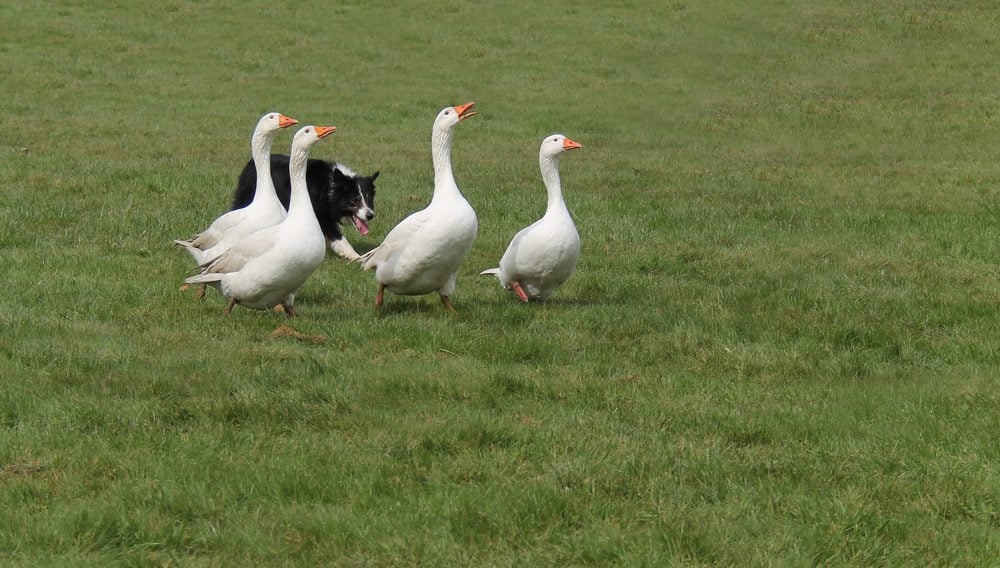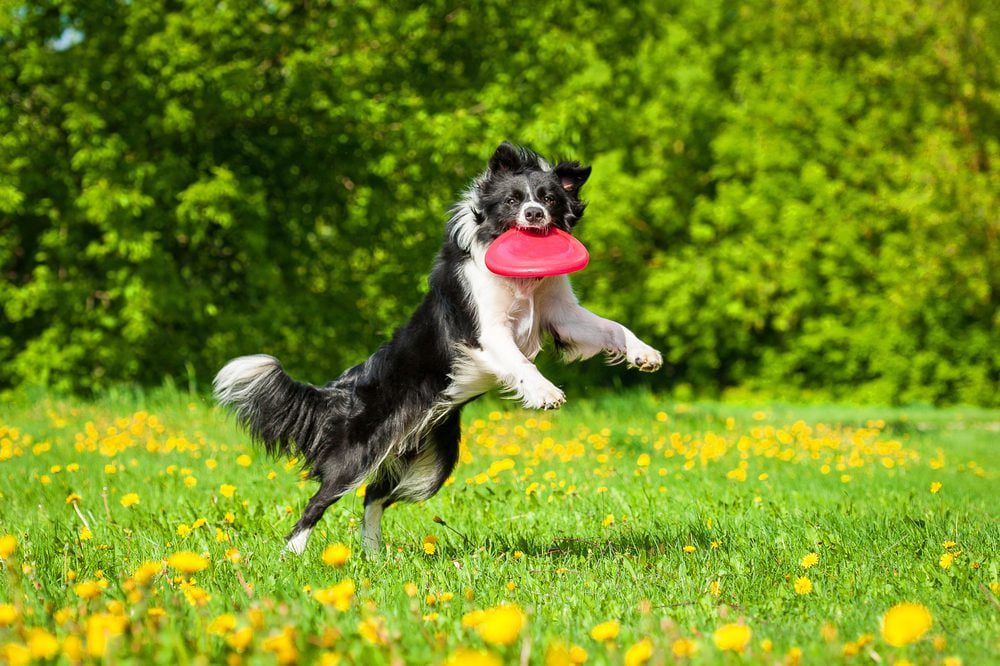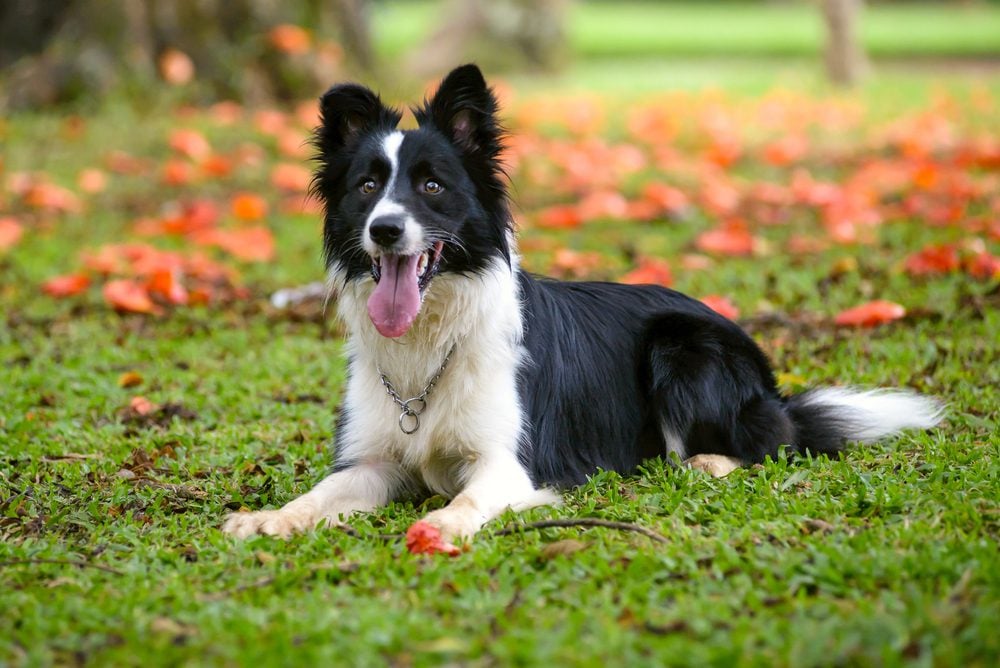Border collies are a popular breed of dog due to their beautiful black and white coat and high levels of intelligence. Originally, the breed comes from Scotland, where they were working dogs used for shepherding flocks of sheep. The name “collie” even comes from the word in the native Scottish language, meaning “sheepdog.”
You may be considering a border collie as the new four-legged addition to your family, but there are some important things to know first.
Getting to Know the Breed
Since border collies were bred with shepherding in mind, they are working dogs through and through. This means that border collies are energetic and intelligent. If they don’t have sufficient stimulation, they can easily become bored. If you’re looking for a couch potato pet, a border collie is not a good choice for you.
Since border collies were bred to be great herders, they still have a herding instinct (more on that later), and they thrive on having a lot of stimulation. These dogs are the ideal choice for farms and small homesteads where you need a dog to work with you to keep other animals safe and under control. They can not only herd sheep but are used in some areas for controlling geese.
The breed is affectionate, which makes them great family dogs that tend to be good with children, though not as much with very small babies. They’re a medium-size breed that averages between 18 and 22 inches tall when full grown, up to 55 pounds. They will need regular brushing and grooming to keep their double coat under control, but the good news is, they don’t drool like some breeds.
Training Your Border Collie
Here are some key things to keep in mind when training your new border collie. Remember that training will take time, so especially when starting with a puppy, you need to be patient. Dogs are pack animals, so if you show them that you are the alpha, they will defer to you. This can help reduce the possibility of future behavioral problems.
Border collies have been ranked as the number one most intelligent dog, even above German shepherds. Border collies can, on average, learn a new command with fewer than five repetitions. Just because these dogs are highly trainable doesn’t mean that everything is smooth sailing. You still need to be aware of the breed’s particular needs so that you can successfully train them and have a great relationship.
Start Training Young
Puppies can start leaving their mothers around 8-12 weeks old, so you can potentially have a very young puppy on your hands. While some owners may worry that their dog will be too young to start training, it’s best to get started right away.
First, it lays the groundwork for a lifelong relationship of your dog trusting and listening to you. Of course, puppies are just like small children, and initially, they won’t learn much. Patience is key.
In the first few weeks you have them at home, you should start with basic commands and focus on getting your pup house-broken. This is a practical place to start that will save your floors and help them build up good habits early on. Of course, there may be some mishaps along the way, so invest in some training pads for your pup, and don’t get discouraged. Reward and commend them when they do get things right and start building that loving companionship with your new four-legged baby.
Since puppies can be harder to reign in, it’s probably best to wait until they are at least six months old to start teaching them more complicated tricks. Make sure they listen to you and know the basics like sit, stay, and bathroom: these commands are a lot more important in their early days than showy tricks.
Training Adult Border Collies
If you adopt an adult border collie, you can still train them. In this case, an old dog can learn new tricks. It may be harder because you may need to break any bad habits they already have established, but border collies are both extremely intelligent and very adaptable. Find out what commands they already know and start there.
Training them to respect you as the alpha is even more essential with an adult dog. Border collies can be strong-willed, meaning they won’t listen to just anyone, and they may see themselves as the alpha. This can be dangerous since a dog that thinks you’re below them in pack hierarchy won’t pay attention to you.
Fortunately, border collies tend to be good-tempered and aren’t naturally aggressive. But, they can be possessive and stubborn. It’s important to be firm with your dog, as they may decide not to listen to you if you are harsh. Maintaining consistency while still being kind is the best way to earn a border collie’s respect and love.
Train in Short Bursts
Because of their high energy levels, border collies can have a short attention span, particularly when they are young. So, expecting your dog to have an hour-long training drill with you is probably unrealistic.
Instead, train them in short bursts of time, focusing on just a few commands to practice in each session. Since border collies need a lot of exercise, you can work training into playtime by practicing some commands between throwing them a frisbee.
Ask your dog to “sit” or give “paw,” and when they successfully carry out the command, commend them and then reward them by throwing their favorite ball or toy for them. Of course, if your dog is excited about their favorite toy, it can be hard to get them to focus on your commands, so you may not want to expect too many tricks from them mid-play. When they finally start to tire out may be the best time to practice with them.
Give Them a Job



When training your border collie, you may want to find some simple tasks or household “jobs” for them to do. Since border collies are workaholics, they like to accomplish tasks and feel needed. Regular jobs help them stay mentally and physically stimulated too.
If you don’t live on a farm, you might struggle to figure out what kind of job your dog can do, but there are plenty of small tasks you can assign your collie to help them get into a routine with the family. For example, they can help with household chores by carrying an empty laundry basket to the dryer for you. They can also walk your child to their bus stop or meet them and walk them home when they get off the bus each day (under your supervision, of course).
Since border collies are herding dogs, they will always have that instinct. You can employ them as a babysitter of sorts when your kids are playing outside. Train them to recognize a command that means it’s time for everyone to come inside, and they will delight in nudging your children back into the house. They can also carry or drag small objects and be your companion for other tasks.
If you have the time to dedicate to it, agility training is another way to employ your dog’s skills. Border collies are very athletic and compete well. You can create an agility training course for your dog to learn and practice, changing it up from time to time to challenge them. Even if you don’t take them to competitions, this will give your dog that extra stimulation to keep them happy and well-behaved.
Behavior to Focus on
When training your dog, there are some key areas to focus on for their safety and your family’s comfort.
Herding/Chasing
As mentioned above, border collies have a strong herding instinct, which can result in an impulse to chase things as well. While you can never completely eradicate the instinct from your dog, teaching them to listen to you and avoid dangerous situations like chasing cars is essential.
The most important thing to teach them is to respect and listen to you. If they trust you and allow your commands to outweigh their impulses, then you can stop them from putting themselves in dangerous positions.
Since border collies will always have the impulse to herd, you can give them safe outlets for this during play if you choose. This helps them safely express themselves in the right context, so they won’t be as likely to herd in inappropriate situations. Still, there will be times when you need to keep this under control.
You can help a dog learn to listen to you and ignore their herding instinct by practicing with them. Have a family member run past the dog while in a safe outdoor space. This will likely trigger their instinct to chase and then herd this person. Before the dog can go after the person, call out for them to come to you. It may take some practice for them to respond, but you can keep them leashed during the first couple of times you practice this exercise.
When your dog comes to you, instead of going after your family member, you should give them a treat as well as a lot of praise and affection. You may need to practice this for a while before you can allow your dog off-leash during this exercise. Once your dog proves responsive, you can feel confident that you can stop them from herding in inappropriate or dangerous situations.
Leash Walking
Training your dog to walk on a leash is essential. Not only is it required by many municipalities, but it also helps keep your dog and everyone else safer. From an early age, you should practice walking them on a leash.
Border collies are very energetic dogs who constantly want to explore what’s around them, and they can be easily distracted as puppies. This can lead to issues like tugging on their leash or trying to lead you in a different direction. It’s important to train them in good leash etiquette from a young age. You may start younger dogs with a harness to prevent them from hurting themselves if they tend to tug a lot.
This is another area where it’s important to have your dog acknowledge you as their pack leader. That way, they stop trying to take control of the walk and allow you to lead.
Socialization
Border collies tend to be very affectionate with their families but can be somewhat reserved with other people and overly enthusiastic when it comes to other dogs. It’s essential that you get your dog the amount of socialization they need. This allows you to train them on what appropriate behavior is when it comes to other people and dogs.
Meeting up with other dog owners to go for walks is an excellent way to practice good behavior. Set up a playdate with one or two other dogs to get them started. Due to border collies’ energy levels and herding instincts, it’s important that they learn to interact with other dogs early on so they know what is acceptable behavior.
Once your dog has interacted with one or two other dogs at a time, you can take them to a local dog park to expose them to a larger group of dogs. Many border collies will love the opportunity to run around and interact with playmates, but it’s still important to keep an eye on them to make sure they don’t offend another dog.
Biting and Chewing
Like many dogs, border collies can bite and chew things like furniture and shoes at a young age. It’s important to correct this behavior as soon as you see it. Within the first few months, some gentle mouthing on objects and even on you is to be expected, but don’t tolerate any hard biting. By the time they are six months old, they shouldn’t be allowed to mouth on your hands or anything other than their toys.
Dogs naturally like to chew things, so giving them toys and treats (like rawhide) to exercise that instinct is important. You can also use these items as training tools. When your pup has the urge to bite or chew, correct them if they go for something like your shoes and give them an appropriate object to chew. They will then start to automatically go for the toy or rawhide whenever the urge strikes.
Barking
Since border collies are herding dogs, they have a loud bark that they can employ to help them on the job. They can also have a tendency to bark in the home. This can be a real problem if you have close neighbors or if your dog tends to interrupt your work or sleep with their barking.
Border collies are easily stimulated, which can trigger barking. If your dog barks once or twice to alert you that there’s a delivery person on your front porch or let you know that their water dish is empty, that’s fine. Your dog is communicating with you.
If they are barking excessively without an obvious direct cause, it could be an emotional response. For example, some border collies bark if they are feeling bored or simply want your attention. They may also be feeling anxious or experiencing separation anxiety if you are in a different room.
Make sure your dog has enough mental and physical stimulation. Also, work to make sure they feel comfortable and are receiving enough attention and affection from the family. Remember, your emotions can also influence your dog. If you are anxious and upset, this can trigger their anxiety as well, so try to stay relaxed and don’t get overly angry with your dog; this can cause more distress.
Crate Training
Most owners will want to crate train their dogs so that there is a safe space for them to be when the need arises. For example, you may want them to go in the crate to give you space while doing household chores, or so they have a designated place to sleep if you don’t want them in your bed.
Starting a puppy on crate training from an early age by using treats rather than force to get them to go inside their crate will help them feel comfortable. Don’t start closing the door of the crate until your puppy is willingly spending time inside. Gradually, your dog will start to recognize this as their safe space where they can rest and wait for you.
It’s important not to leave young puppies in a crate for too long since they don’t have the same bladder and bowel control as adult dogs. Even adult dogs shouldn’t generally be crated for more than 8 hours.
Border collies are full of energy, so after being in a crate all day, they will need to get out and exercise. Being in a closed crate all day, every day, isn’t healthy for this breed since they thrive on stimulation.
Keys to Success



Now that you know some of the most important aspects of training your border collie, here are a few general tips to make your training more effective and rewarding for both of you.
Environment
Since young border collies can be easily distracted by outside stimuli, you should choose the right environment for training. A spacious yard that’s free from other people and animals or a secluded area of a similarly empty park is best.
If there’s too much activity going on, your dog can lose focus, which might be frustrating for you.
Positive Reinforcement
Border collies are very intelligent and can learn new words and commands quickly. However, it can still take some time to get a wiggly and excited puppy to settle down and listen. No matter how tired you are or how many repetitions it took, you should always take the time to praise your dog when they successfully complete a task or obey a command.
Treats are great, but often, dogs want our approval most of all. Make sure to verbally praise your dog and give them pets. Remember, your dog can read your tone of voice and facial expression.
Consistency
It’s important to be consistent when training. For instance, you shouldn’t say “no” to your dog sleeping in the bed one night, but “yes,” another. This will only confuse them and can cause your border collie to become stubborn. Use consistent commands as well during training, so your dog always knows what you mean and how to respond.
Stimulation
As we’ve mentioned, border collies are smart and physically active. It’s important that they receive enough physical and mental stimulation to keep them happy and prevent behavioral issues. When it comes to border collies, many problems can be boiled down to not enough activity or attention.
Make sure they get enough outdoor play, practice tricks with them, and you can even buy them puzzle toys to keep them occupied.
Successfully Training Your Border Collie
Border collies are great dogs, and it’s no wonder that they are such a popular breed. However, they won’t suit many people’s lifestyles. Having enough time to dedicate to training your dog is essential when it comes to border collies. And through adulthood, they will still need plenty of time and attention. You’re building a lifelong relationship when you adopt or purchase a dog, after all.
Fortunately, these intelligent dogs are relatively easy to train when given the proper amount of stimulation. Of course, some dogs may have issues with anxiety, and some first-time dog owners may struggle with training. You can always enroll your dog in training school if you find it particularly challenging to know where to begin. These courses can help you get started building a relationship with your dog and laying a foundation of obedience. But many border collies can be effectively trained at home. We hope our list has given you helpful guidelines and prepared you for what to expect with your border collie.
